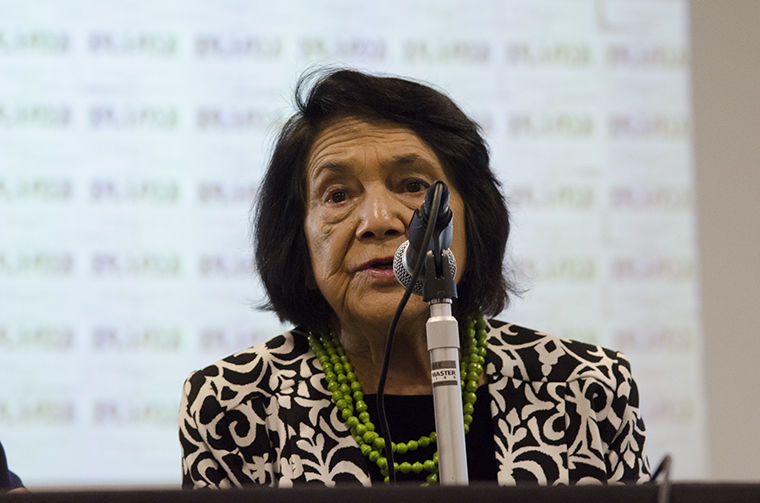Dolores Huerta talks activism, politics
October 25, 2017
When Dolores Huerta started her career as an activist with labor leader Cesar Chavez in the 1960s, farm workers were working in the fields for 12 hours a day for only 70 cents per hour without restrooms or drinking water, she said.
Huerta—a labor leader and civil rights activist—shared the 1960s United Farm Workers’ storyof the battle to unionize migrant workers at an Oct. 19 panel along with Paul R. Chavez, the grandson of UFW Co-founder Cesar Chavez.
Huerta and Paul R. Chavez came to Columbia’s campus as part of the Humanities, History and Social Sciences Department’s “¡Sí, Se Puede!” exhibition, which showcases art inspired by archives from Huerta and Cesar Chavez’s work with the United Farm Workers union founded in 1962, as reported Sept. 5 by the Chronicle.
During her visit, Huerta walked through the “¡Sí, Se Puede!” exhibition. Panel moderator and HHSS Department Associate Professor Wilfredo Cruz asked Huerta about the origin of her coined phrase, “¡Sí, Se Puede!” during the panel.
“The reason [the phrase] has so much power is because it does not only mean what an individual can do, but it also means collective power,” Huerta said.
Paul R. Chavez added that “¡Sí, Se Puede!” is still used today, and parallels former President Barack Obama’s, ‘Yes We Can’ slogan. “That demonstrates how empowering [Huerta’s] saying was,” Chavezsaid.
Neve Rosales, a freshman audio arts and acoustics major who attended the event, said Huerta is iconic.
“Hearing her words inspired [me] to be active in our own communities and [give] Latinx representation,” Rosales said.
Both panelists encouraged students to volunteer and work in local elections and activism.
“The whole thing is about people power,” Huerta said. “If the protests and marches don’t go to the ballot box, there can’t be changes. Don’t wait to be invited; just go join the picket line.”
Huerta said the didivisiveness of the current political climate has become a call to action for activists.
“We [have to] push more to make sure women and people of color are represented in organizations,” Huerta said. “We have to teach our kids what the contributions are from people of color—[which] is not taught in our school books—and unless we start teaching that, we are not going to get rid of the racism in our society.”
Meg Duguid, director of exhibitions in the Department of Exhibitions, Performance and Student Spaces and curator of “¡Sí, Se Puede!,” said once the exhibition ends Nov. 4, Columbia hopes to make it a traveling exhibition moved to Wayne State University where the original archives from the UFW are located.
“I will hold lessons [from] the panelists in my life for the rest of my life,” Duguid said. “People power is the thing that makes the world go round. I would like to think that every person took away their own lessons from [the evening].”








